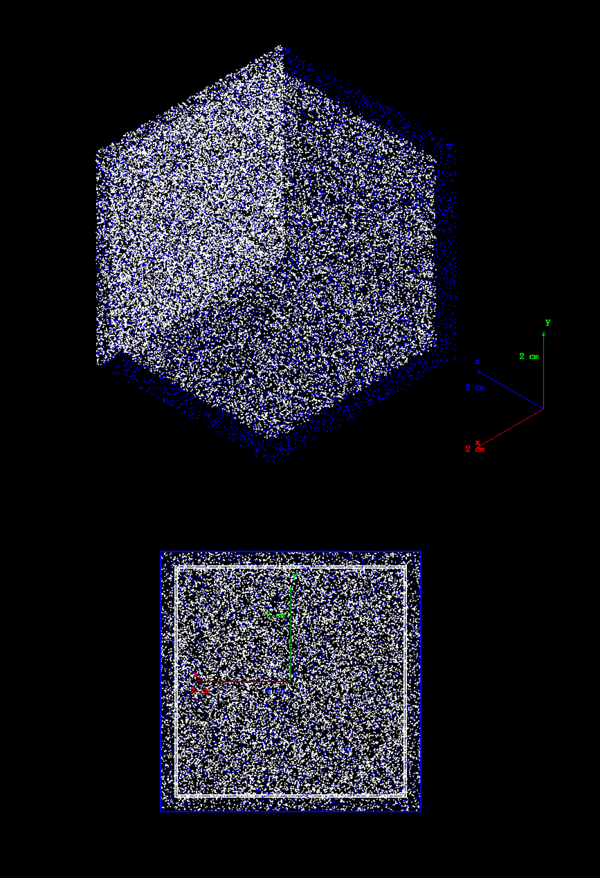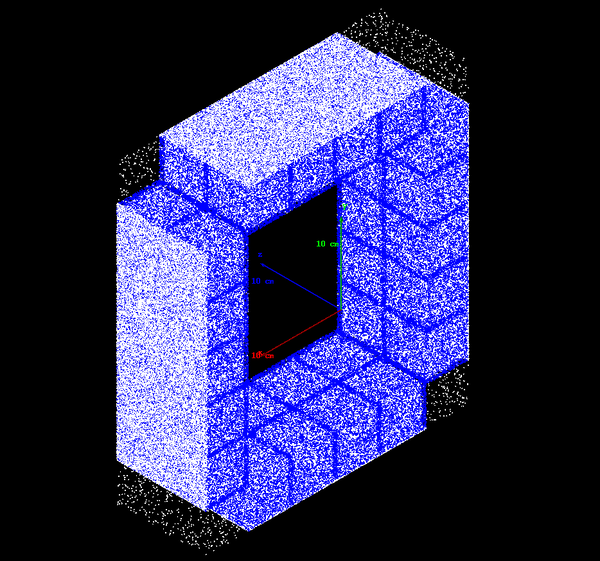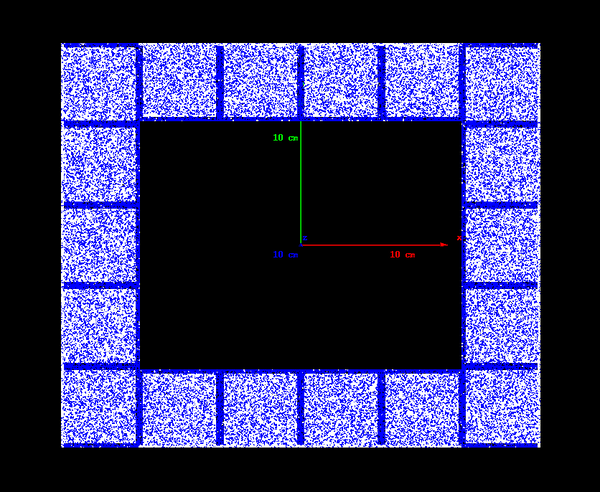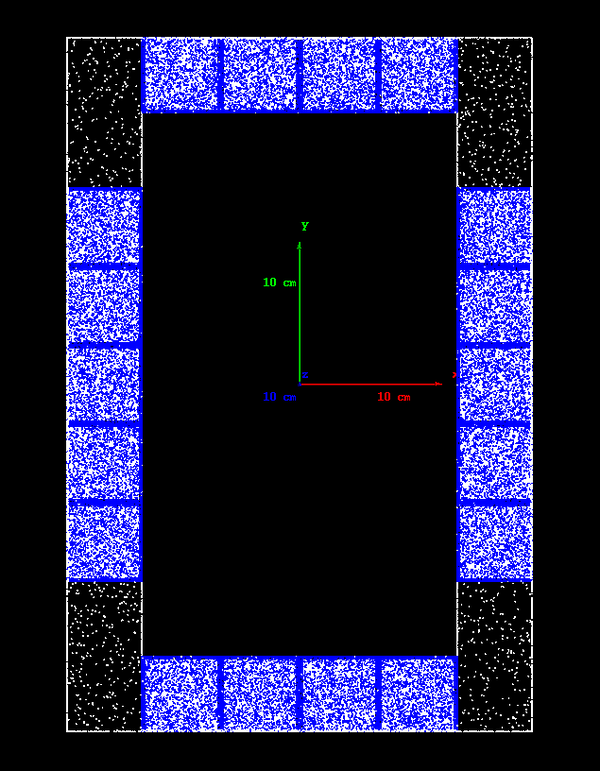You are here: Foswiki>SubExp_Chalmers Web>SimGCB (08 Apr 2024, BjörnJohansson)Edit Attach
-- BjörnJohansson - 05 Apr 2024

 The default behavior places four detectors horizontally and five detectors vertically on each side of the origin, two rings in total. There is also a small overlap of 0.5 cm, meaning that 0.5 cm of the top and bottom row covers the side rows. Further down, an illustraion will show this more clearly. But first, let us take a look at the help text.
The default behavior places four detectors horizontally and five detectors vertically on each side of the origin, two rings in total. There is also a small overlap of 0.5 cm, meaning that 0.5 cm of the top and bottom row covers the side rows. Further down, an illustraion will show this more clearly. But first, let us take a look at the help text.
 We can also add a negative number to the overlap placing the top and bottom row further away from the origin. If we, for example, add overlap=-5.25cm we will have a large space between the top/bottom and the side rows.
We can also add a negative number to the overlap placing the top and bottom row further away from the origin. If we, for example, add overlap=-5.25cm we will have a large space between the top/bottom and the side rows.

Simulation of Cerium Bromide (CeBr3) Detectors
The (Gamma) Cerium Bromide detector (gcb) consists of an active volume of CeBr3 surrounded by a thin reflector material of TiO2 inside a casing of aluminum with a back panel of glass. The first section will describe the properties of the detector and the following section will describe an arrangement of gcbs', called gcba.Cerium Bromide Detector
The first image is a representation of the detector in GEANT4 from two angles. The blue coloured part represents the casing material and inside is the reflector and active part in white. The backside of the detector in white is the glass panel (called window in ggland). In the picture of the front side, there is a small white frame which is the reflector material which covers the active part on all sides except the backside where the glass window is.

Help text in ggland
To get updated information on the detector and its parameters, type gcb=help to get the following output:
Parse: gcb
rot{x,y,z}|x0|y0|z0 0 1|cm Rotation | Location. (Cumulative.)
dx 4.8 cm Width of the active crystal.
dy 4.8 cm Height of the active crystal.
dz 4.8 cm Thickness of the active crystal.
rthick 0.05 cm Thickness of the reflector.
wthick 0.1 cm Thickness of the window.
cthick 0.3 cm Thickness of the casing.
type CeBr3 Active material of detector.
ctype Al Casing material of detector.
rtype TiO2 Reflector material of detector.
wtype glass Window material of detector.
enter 0 Include incoming particles in tree.
sigma_x 0.02 cm x blurring in tree output.
sigma_y 0.02 cm y blurring in tree output.
sigma_z 0.02 cm z blurring in tree output.
sigma_e 0.01 e blurring in tree output.
sigma_t 3 ns t blurring in tree output.
noblur Do not randomise clusterized
x,y,z,t,e output.
spec=DET-ABC With specification of DET-ABC,
location not taken, given explicitly.
inside=DET-ABC Inside root volume of DET-ABC.
tree-sort-by-t Sort clusters by time instead of decreasing energy.
tree-num-clusters=N Number of clusters to include (default 10).
tree-max-cluster=N Maximum length of a cluster (default 10 cm).
tree-cluster-coord=[world|det|seg] Cluster coordinate (default det).
tree-keep-cluster-prob=[I=]P Prob. to keep cluster (per subvolume I).
tree-keep-event-prob=[I=]P Prob. to keep all clusters (per subvolume I).
tree-gun-edep Record total deposited energy for each primary.
tree-name=NAME Override default name.
These are the parameters that can be changed, with their default values and a short description of each parameter. Always refer to the ggland output for an updated description, not the copy above.
Using the CeBr3 Detector
A small script to use the gcb:
./land_geant4 --gcb=z0=3cm\
--gun=gamma,T=10MeV,isotropic \
--world=type=vacuum --events=5000 \
--tree=digi,test.root
This places the detector 2 cm after the target (in the beam direction) with the glass window facing away from the target. In the root tree, the detector's output will (by default) start with GCB and stores energy, position and time for hits reaching the active volume. With the digi option in --tree, the detector's digitizer is added to the output tree. The digitizer will give output mimicking the real detector and its outputs in the root tree will start with a d after the detector name, e.g. GCBd. It stores energy and time. If we want CeBr3 detectors to surround the target, the premade CeBr3 arrangement might be preferred instead of calling gcb multiple times.
GCBA, Cerium Bromide Arrangement
#GCBArr
The (gamma) CeBr3 arrangement, gcba, consists of several gcb detectors arranged in "square rings" with the back panel (window) facing away from the target, as seen in the picture. The small amount of white dots in the corners are the edges of the mother volume but has the same medium as the --world=type. Thus, it does not affect particles going through that space but one should be careful to not place another object so that it intersects with those corners. The default behavior places four detectors horizontally and five detectors vertically on each side of the origin, two rings in total. There is also a small overlap of 0.5 cm, meaning that 0.5 cm of the top and bottom row covers the side rows. Further down, an illustraion will show this more clearly. But first, let us take a look at the help text.
The default behavior places four detectors horizontally and five detectors vertically on each side of the origin, two rings in total. There is also a small overlap of 0.5 cm, meaning that 0.5 cm of the top and bottom row covers the side rows. Further down, an illustraion will show this more clearly. But first, let us take a look at the help text.
Help text in ggland
Just as before, typing -gcba=help_ in ggland will produce the help text. As this consists of several gcb detectors the output will look very much alike but has four more options, marked with arrows.
Parse: gcba
An arrangement of gcb in a hollow square configuration.
rot{x,y,z}|x0|y0|z0 0 1|cm Rotation | Location. (Cumulative.)
dx 4.8 cm Width of the active crystal.
dy 4.8 cm Height of the active crystal.
dz 4.8 cm Thickness of the active crystal.
rthick 0.05 cm Thickness of the reflector.
wthick 0.1 cm Thickness of the window.
cthick 0.3 cm Thickness of the casing.
type CeBr3 Active material of detector.
ctype Al Casing material of detector.
rtype TiO2 Reflector material of detector.
wtype glass Window material of detector.
zdets 2 Number of (rectangular) rings. <---------------
ydets 5 Number of detectos on the sides (along <---------------
y axis).
xdets 4 Number of detectos on top and bottom <---------------
(along x axis).
overlap 0.5 cm Detector 'overlap' in x-y corners. <---------------
enter 0 Include incoming particles in tree.
sigma_x 0.005 cm x blurring in tree output.
sigma_y 0.005 cm y blurring in tree output.
sigma_e 0.035 e blurring in tree output.
noblur Do not randomise clusterized
x,y,z,t,e output.
spec=DET-ABC With specification of DET-ABC,
location not taken, given explicitly.
inside=DET-ABC Inside root volume of DET-ABC.
tree-sort-by-t Sort clusters by time instead of decreasing energy.
tree-num-clusters=N Number of clusters to include (default 10).
tree-max-cluster=N Maximum length of a cluster (default 10 cm).
tree-cluster-coord=[world|det|seg] Cluster coordinate (default det).
tree-keep-cluster-prob=[I=]P Prob. to keep cluster (per subvolume I).
tree-keep-event-prob=[I=]P Prob. to keep all clusters (per subvolume I).
tree-gun-edep Record total deposited energy for each primary.
tree-name=NAME Override default name.
The added parameters controls the number of detectors in each direction; top and bottom (xdets), left and right side (ydets) and number of "rings" (zdets). There's also the overlap option which is covered below.
Using the GCBA
First, let us look at a script of the gcba:
./land_geant4 --gcba=z0=5.5cm\
--gun=gamma,T=10MeV,isotropic \
--world=type=vacuum --events=50000 \
--tree=digi,test.root
This will place the arrangement so that the first ring starts at the same (z) position as the target as the default dimension of the CeBr3 is 5.5 cm wide. The same parameters that can be changed for the gcb can of course be changed in the gcba as well. In addition, the xdets, ydets and zdets parameters controls the number of detectors in each direction. By default there is also a small overlap of the detectors in the corners by 0.5 cm. If we increase the overlap to 4 cm by adding overlap=5.25cm (the above example would be --gcba=z0=5.5cm,overlap=5.25cm), we see that the xdets and ydets form a complete rectangle, with a detector at each corner. (5.25 cm is the default thickness of a CeBr3 detector.)
#GCBOverlap
 We can also add a negative number to the overlap placing the top and bottom row further away from the origin. If we, for example, add overlap=-5.25cm we will have a large space between the top/bottom and the side rows.
We can also add a negative number to the overlap placing the top and bottom row further away from the origin. If we, for example, add overlap=-5.25cm we will have a large space between the top/bottom and the side rows.

Edit | Attach | Print version | History: r3 < r2 < r1 | Backlinks | View wiki text | Edit wiki text | More topic actions
Topic revision: r3 - 08 Apr 2024, BjörnJohansson
 Copyright © by the contributing authors. All material on this collaboration platform is the property of the contributing authors.
Copyright © by the contributing authors. All material on this collaboration platform is the property of the contributing authors. Ideas, requests, problems regarding Foswiki? Send feedback
